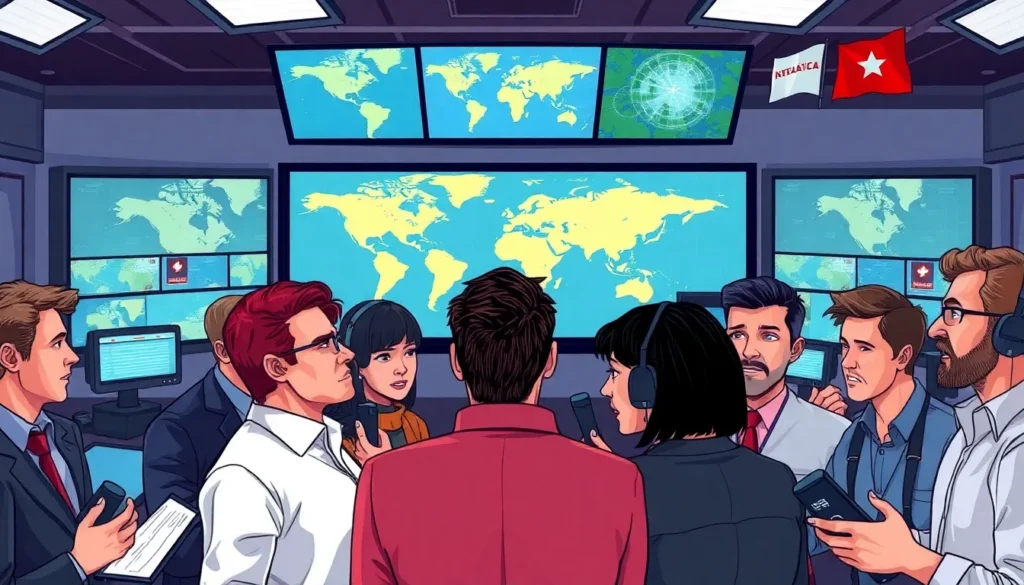In a world where news travels faster than a cat meme, keeping up with international affairs can feel like trying to drink from a fire hose. From trade wars to climate change, these global happenings shape our lives in ways we often overlook. Yet, understanding the intricacies of international relations is crucial if one wants to navigate the chaos and avoid the pitfalls of ignorance.
Table of Contents
ToggleOverview of International Affairs Coverage
International affairs coverage encompasses a variety of topics, such as diplomacy, global trade, conflict, and environmental issues. News outlets provide analysis of significant events that shape international relations. Global politics often reflect broader societal trends, influencing everything from local economies to individual livelihoods.
Media organizations focus on major issues like trade wars and climate change, impacting millions worldwide. Accessibility to reliable news sources is crucial for maintaining awareness of these matters. Platforms that prioritize in-depth reporting over sensationalism deliver more accurate representations of complex situations.
Understanding international affairs offers valuable insights into the interconnected nature of modern society. Coverage helps individuals grasp how international policies affect local environments, revealing the implications of decisions made far beyond their borders. Journalists play a vital role in unpacking these narratives, ensuring citizens remain informed.
Investigative reporting sheds light on underreported issues, including human rights abuses and economic inequalities. In a rapidly changing global landscape, real-time updates create awareness around critical events, compelling audiences to engage with the content. As stories unfold, timelines and analyses contribute to the understanding of long-term consequences.
Multimedia platforms enhance engagement, delivering news through various formats, like articles, podcasts, and videos. Social media amplifies international affairs discourse, allowing users to share opinions and highlight pressing concerns. The evolution of technology has transformed how audiences consume news, making it easier to access diverse perspectives.
Staying informed about international affairs facilitates informed decision-making. Knowledge of global issues fosters empathy and understanding, bridging cultural divides. Individuals who seek out this information engage meaningfully with the world’s challenges, leading to more thoughtful conversations and actions within their communities.
Importance of International Affairs Coverage

International affairs coverage plays a critical role in shaping perceptions of global events. Understanding these topics bridges gaps in knowledge, fostering greater awareness of the world’s interconnectedness.
Role in Global Awareness
International affairs coverage cultivates global awareness by shining a light on pressing issues. Journalists report on significant milestones, such as treaties and conflicts, providing context that enhances comprehension. Additionally, coverage of climate change underscores its impact on populations worldwide, illustrating shared challenges. By disseminating information about diplomatic efforts, it encourages public discourse and collective action. Engaging with reliable sources expands insights into global trends, which directly affect local communities.
Impact on Public Opinion
Public opinion significantly shifts based on international affairs coverage. News reporting shapes how audiences perceive foreign policies, trade relations, and humanitarian crises. With accurate narratives, news outlets can influence attitudes toward international cooperation. Furthermore, highlighting underreported issues, such as human rights abuses, prompts organizations and individuals to act. Diverse perspectives foster informed discussions, resulting in a more engaged citizenry. Consequently, citizens form opinions rooted in comprehensive understanding rather than misinformation.
Challenges in International Affairs Coverage
Coverage of international affairs faces significant challenges that impact the accuracy and depth of information. Journalists contend with various factors that hinder comprehensive reporting on global issues.
Media Bias and Objectivity
Media bias presents a substantial obstacle in international affairs coverage. Reporters and news outlets often reflect specific political viewpoints, which color the presentation of facts. This bias can influence audience perceptions, skewing their understanding of nuanced international events. Objectivity becomes essential for providing a balanced view. By striving for neutrality, journalists can foster more informed audiences capable of forming opinions on events without prejudice. Strategies such as fact-checking and using multiple sources help mitigate bias, promoting accuracy in reporting.
Accessibility and Reporting Limitations
Accessibility to reliable information poses another challenge in international affairs. Journalists face constraints such as limited resources and access to critical areas. These limitations can obstruct thorough coverage of pressing issues like humanitarian crises and geopolitical tensions. Additionally, language barriers effectively restrict understanding in regions where local media may lack international reach. Innovative approaches, including collaboration with local journalists, enable broader perspectives on complex topics. Prioritizing diverse voices ensures critical stories receive the attention they require, ultimately supporting a more informed global audience.
Innovations in International Affairs Coverage
Innovative approaches greatly enhance international affairs coverage, adapting to rapid changes in global communication and audience engagement.
Digital Platforms and Social Media
Digital platforms revolutionize the delivery of international news. Social media facilitates real-time updates, allowing audiences to access diverse viewpoints instantly. User-generated content creates opportunities for local voices to share their experiences, enhancing the information landscape. Platforms like Twitter and Facebook enable journalists to engage directly with audiences, fostering dialogue around critical issues. News organizations harness analytics tools to tailor content to audience preferences, ensuring relevancy in coverage. Algorithms also amplify significant stories, driving awareness of underreported events. Such innovations bridge gaps between complex global narratives and everyday understanding.
Emerging Journalistic Techniques
Emerging journalistic techniques transform the landscape of international affairs reporting. Data journalism provides in-depth insights, revealing patterns in global events through statistical analysis. Multimedia storytelling combines videos, podcasts, and infographics, making complex topics accessible and engaging. Investigative techniques, such as collaborative journalism, allow journalists to unite resources for comprehensive reporting. Fact-checking initiatives promote accuracy amidst misinformation, fostering trust in news sources. Furthermore, immersive technologies, like virtual reality, offer audiences firsthand experiences of international crises, deepening empathy and understanding. These techniques help journalists break down barriers to global awareness, creating a more informed audience.
Staying informed about international affairs is crucial for navigating today’s interconnected world. As global issues increasingly impact local lives understanding these dynamics fosters informed discussions and empathetic responses. Accessing reliable news sources and engaging with diverse perspectives empowers individuals to form well-rounded opinions.
Innovations in reporting continue to shape how international news is consumed. Embracing new technologies and collaborative approaches enhances the depth and accessibility of coverage. This evolution not only informs but also inspires collective action and dialogue around pressing global challenges.
By prioritizing comprehensive international affairs coverage individuals can better appreciate the complexities of global relationships and contribute to a more informed and engaged society.






